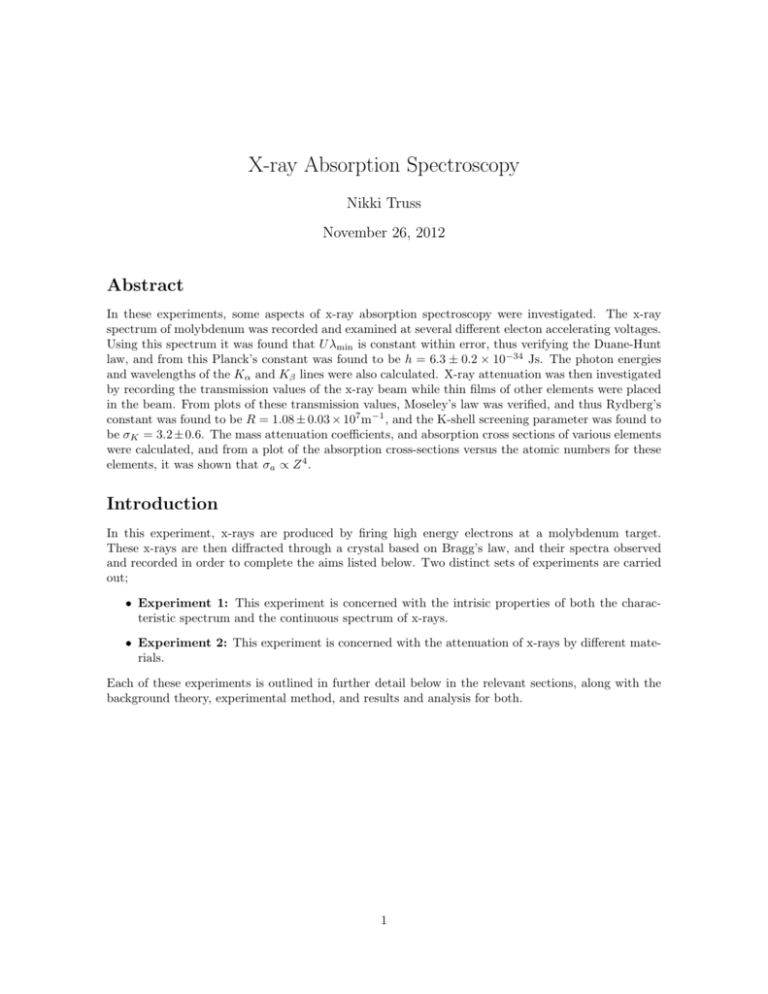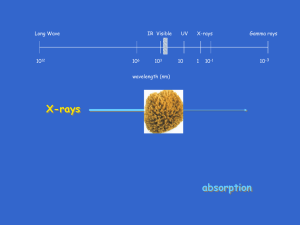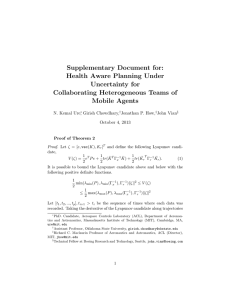X-ray Absorption Spectroscopy
advertisement

X-ray Absorption Spectroscopy Nikki Truss November 26, 2012 Abstract In these experiments, some aspects of x-ray absorption spectroscopy were investigated. The x-ray spectrum of molybdenum was recorded and examined at several different electon accelerating voltages. Using this spectrum it was found that U λmin is constant within error, thus verifying the Duane-Hunt law, and from this Planck’s constant was found to be h = 6.3 ± 0.2 × 10−34 Js. The photon energies and wavelengths of the Kα and Kβ lines were also calculated. X-ray attenuation was then investigated by recording the transmission values of the x-ray beam while thin films of other elements were placed in the beam. From plots of these transmission values, Moseley’s law was verified, and thus Rydberg’s constant was found to be R = 1.08 ± 0.03 × 107 m−1 , and the K-shell screening parameter was found to be σK = 3.2 ± 0.6. The mass attenuation coefficients, and absorption cross sections of various elements were calculated, and from a plot of the absorption cross-sections versus the atomic numbers for these elements, it was shown that σa ∝ Z 4 . Introduction In this experiment, x-rays are produced by firing high energy electrons at a molybdenum target. These x-rays are then diffracted through a crystal based on Bragg’s law, and their spectra observed and recorded in order to complete the aims listed below. Two distinct sets of experiments are carried out; • Experiment 1: This experiment is concerned with the intrisic properties of both the characteristic spectrum and the continuous spectrum of x-rays. • Experiment 2: This experiment is concerned with the attenuation of x-rays by different materials. Each of these experiments is outlined in further detail below in the relevant sections, along with the background theory, experimental method, and results and analysis for both. 1 Experiment 1: The X-ray Spectrum Introduction A typical x-ray spectrum produced by an x-ray tube consists of two components. The first of these components is the sharp lines, which are called the characteristic spectrum. These lines are superimposed onto a smooth curve called the continuous spectrum. This second component of the spectrum is due to brehmsstrahlung, radiation produced by the deceleration of the electons striking the molybdenum target, and it extends to a minimum wavelength λmin . The kinetic energy E of the incident electrons is given by E = eU (1) where U is the accelerating voltage of the electrons (i.e. the tube voltage), and e is the charge on the electron. The energy of the x-ray photon is given by E = hν = hc λ (2) where h is Planck’s constant, c is the speed of light in a vacuum, and ν and λ are the frequency and wavelength of the emitted photon, respectively. Equating equations (1) and (2), we find that the minimum wavelength λmin is given by hc = eU = Emax λmin (3) otherwise known as the Duane-Hunt law, or the inverse photoelectric effect. Incident electrons can knock electrons out of one of the inner shells of the target atom, this gap is then filled by an electron falling from an outer shell, thereby emitting a photon. The characteristic spectrum is due to these electron transitions. We see two distinct peaks, known EKα and EKβ , these are due to electrons transitioning from the L to K shells, and M to K shells respectively. Using the modified Bohr model of the atom, we can find an expression for the binding energy of the electrons in a shell of quantum number n Z2 En = −Rhc eff (4) n2 where Zeff = Z − σm , R is the Rydberg constant, and σm is the screening constant, which is approximately equal to 1 for the transitions we are concerned with. In this experiment the x-rays are diffracted by a crystal according to the Bragg law nλ = 2d sin β where n is the order of the image (we are only concerned with n=1), d is the atomic spacing, and β is the angle of difraction. For an NaCl crystal 2d = 563 × 10−12 m, and we are only concerned with the first order image, therefore λ = 563 × 10−12 sin β (5) 2 Aims The aims of experiment 1 are as follows; • To record the x-ray spectrum of molybdenum at several different at several different accelerating voltages, U , of the electrons. • To show that U λmin is constant and to determine Planck’s constant. • To measure the photon energies, and wavelengths, of the Kα and Kβ lines in the characteristic spectrum of molybdenum. • To compare these values with calculated values. Experimental Method The x-rays are emitted form a molybdenum anode. Emission is switched off if the leaded glass door of the containment chamber is open. To disperse the x-rays into their spectrum, they are diffracted through a (100) NaCl crystal, using Bragg geometry. The crystal is clamped against a small horizontal bar in its preferred orientation. The spectra of I vs β is recorded for various tube voltages.From the spectra, the λmin values and the wavelengths of the Kα and Kβ lines are determined. The corresponding photon energies, Emax , EKα and EKβ are calculated. The values of these quantities are tabulated and it is verified that the U λmin values are constant within error. Planck’s constant is calculated. Using the modified Bohr model,the expected values of EKα and EKβ for molybdenum are calculated and compared with the measured values. Results and Analysis The x-ray spectra obtained in this experiment are shown below in figure 1. From the spectra, the location of βmin was estimated for each U , then using equation (5) the values for λmin were calculated. Figure 1: X-ray spectra of molybdenum for tube voltages of 35, 30, 25, and 20 kV 3 The values of the product U λmin were then calculated and tabulated below in table 1. It is clear that the value of U λmin is constant within experimental error. To calculate the maximum photon energies Emax for each tube voltage, equation (3) was used. This equation was also used to calculate Planck’s constant for each U . U (V) 35000 ± 100 30000 ± 100 25000 ± 100 20000 ± 100 λmin (pm) 33 ± 1 39 ± 1 48 ± 1 61 ± 1 U λmin (10−6 V m) 1.17 ± 0.05 1.18 ± 0.04 1.20 ± 0.04 1.22 ± 0.03 Emax (keV) 37 ± 1 32 ± 1 25.8 ± 0.8 20.4 ± 0.5 h (10−15 eVs) 3.9 ± 0.2 3.9 ± 0.2 4.0 ± 0.1 4.1 ± 0.1 Table 1: Experimental values for U and λmin Taking the average of the values for Planck’s constant we obtain a value of h = 3.9 ± 0.1 × 10−15 eVs. This is equivalent to h = 6.3 ± 0.2 × 10−34 Js. The wavelengths of the Kα and Kβ lines were found in a similar manner to λmin . To find the corresponding photon energies EKα and EKβ , equation (2) was used. The values calculated for each of these quantities are tabulated below in table 2. λKα (pm) 70.6 ± 0.9 λKβ (pm) 62.8 ± 0.9 EKα (keV) 17.5 ± 0.3 EKβ (keV) 19.8 ± 0.3 Table 2: Experimental values for photon energies and wavelengths of the Kα and Kβ lines For EKα we are concerned with the transition from the L to K shell, so we take EKα = E2 − E1 . For EKβ we are concerned with the transition from the M to K shell, so we take EKβ = E3 − E1 . We then derive the following results EKα = 3Rhc 2 Zeff , 4 EKβ = 8Rhc 2 Zeff 9 Taking σm ≈ 1, we find that the expected values are EKα ≈ 17.584 keV and EKβ ≈ 19.77 keV. 4 Experiment 2: X-ray Attenuation Introduction When x-rays pass through a material their intensity is reduced as a result of both absorption and scattering according to the following relationship T = I R = I0 R0 (6) where T is the transmittance and I, I0 , R, and R0 are the intensities and count rates with and without the foils respectively. The decrease in absorption is proportional to the atomic number of the absorbing element, and inversely proportional to the incident x-ray photon energy. At certain energies there is a an abrupt change in absorption, these are called the absorption edges. For a slab of material of thickness x the following relationship holds I = I0 e−σnx = I0 e−µx (7) where I0 is the incidenty intensity, µ = σn is the linear attenuation coefficient, and σ is the removal cross section. From these equations (4) and (5) we can then see that µ= − ln T x (8) Using n = Na ρ/A where Na is Avogadro’s number, and A is the atomic weight of the material of density ρ, then µ A µ σ= = (9) n Na ρ where µ/ρ is called the mass attenuation coefficient. Since photons can be removed from the beam by either absorption or scattering, σ can be written as σ = σa + σs where σa and σs are the partial removal cross-sections associated with absorption and scattering, respectively. In the case of this experiment σs < σa and can be approximated as σs ≈ 0.02A Na We can therefore find σa for each foil A µ − 0.02 σa ≈ ρ Na (10) Absorption of energy can take place via various mechanisms. In these experiments, the x-ray photons have energies in the range of 10 - 40 keV, and so attenuation is dominated by the photoelectric effect, i.e. the energy of the photons is used to eject a bound electron from the absorbing material. For the ejection of a K shell electron, we require hν ≥ binding energy of K shell electron A jump in attenuation is seen when the incident photon energy reaches this binding energy, for the K shell this jump is known as a K-absorption edge. At this edge EK = hc = Rhc(Z − σK )2 λK 5 (11) where EK is the energy at absorption edge, i.e the wavelength of the absorption edge λK is given by Moseley’s law r √ √ 1 RZ = + RσK (12) λK At a fixed wavelength, away from an edge, the absorption removal cross-section σa increases rapidly as the atomic number Z increases, i.e σa ∝ Z p , otherwise written as σa = CZ p where C is a constant. Taking the natural log of both sides we find that ln σa = p ln Z + ln C (13) Section A: K-absorption Edge Aims The aims of experiment 2, section A are as follows; • To determine the energy, EK at the K absorption edge for zirconium, molybdenum, silver and indium. • To show that EK ∝ (Z − σK )2 . • To determine the Rydberg constant, R, and the value of σK . Experimental Method The experimental apparatus is the same as that used in experiment 1. As before, the NaCl crystal is used to disperse the spectrum. To determine the K absorption edge for several different materials, the x-ray spectrum of molybdenum is recorded with and without thin foils of these metals inserted in the x-ray beam. All 5 spectra are printed on a single plot. Transmission values are calculated for a couple of the data points and compared with the plotted values. From the plots of T versus λ, λk and Ek in keV for each foil are evaluated and tabulated. A suitable graph to verify the relation Ek = Rhc(Z − σk )2 is plotted, and from this graph both the Rydberg constant R and the K shell screening parameter σk are determined. 6 Results and Analysis The spectra obtained in this experiment are shown below in figure 2 (a) X-ray spectra β scale (b) X-ray spectra λ scale Figure 2: X-ray spectra for molybdenum with foils of Zr, Mo, Ag, and In placed in the beam 7 A plot of the transmission of each foil versus λ was also obtained, shown below in figure 3. Figure 3: Transmission of x-rays of various wavelengths through foils of Zr, Mo, Ag, and In In order to ensure the accuracy of the values produced by the computer, transmission values were calculated for some of the data points, using equation (6) these are tabulated below in table 3. Value Calculated Plotted Zr 0.85556 0.856 Mo 0.2556 0.256 Ag 0.3673 0.367 In 0.0466 0.047 Table 3: Calculated and plotted Transmission values From this plot the wavelength of the K-absorption edge, λK , for each foil was estimated, and using equation (3), the energy at the K-absorption edge, EK was calculated. These values are tabulated below in table 4. Element Zr Ag Mo In Atomic Number 40 42 47 49 λK (pm) 68 ± 2 62 ± 2 48 ± 2 44.3 ± 0.9 EK (keV) 18.2 ± 0.6 20.1 ± 0.6 26 ± 1 28.1 ± 0.6 Table 4: Wavelengths and photon energies of the K-absorption edge 8 −1/2 A graph of λK versus the atomic number, Z, was then plotted, seen below in figure 4 and using equation (12), values for the Rydberg constant, R = 1.08 ± 0.03 × 107 m−1 and the K shell screening parameter σK = 3.2 ± 0.6 were found. (a) Plot showing intercept (b) Zoom of the region of interest Figure 4: Plot of K-edge wavelength versus atomic number Section B: Mass Attenuation Coefficient and Absorption Cross-Section Aims The aims of experiment 2, section B are as follows; • To determine the mass attenuation coefficient, µ/ρ, and absorption cross-section, σa , for aluminium, iron, copper, and zirconium, at a fixed wavelength away from the absorption edges. • To find the dependence of σa on Z at this wavelength. Experimental Method The experimental apparatus is the same as that used in the previous experiments. As before, the NaCl crystal is used to disperse the spectrum. Both µ/ρ and σa are calculated for each foil by measuring its transmittance at a chosen wavelength, well below an edge but not so low that the intensity has become too small, the value chosen for this experiment was 41.3pm. The count rate is measured first with no foil, and then with each of the foils respectively, thus the transmittance for each foil is calculated. A graph of σa versus Z is plotted, then a suitable graph to show that σa ∝ Z p is plotted and p is determined. 9 Results and Analysis The count rates for each foil were compared to a base count rate with no foil to calculate transmission values according to equation (6). Values for µ were then calculated using equation (8), and using the given density values, the mass attenuation coefficient, µ/ρ, was then calculated for each foil. The absorption cross sections for each foil, σa , were then found using equation (10). These values are tabulated below in table 5. Element Al Fe Cu Zr Atomic Number 13 26 29 40 µ/ρ 10−2 (m2 kg−1 ) 9.7 ± 0.7 79 ± 5 91 ± 6 237 ± 17 σa 10−25 (m2 ) (=kb) 35 ± 2 721 ± 51 944 ± 67 3579 ± 253 Table 5: Experimental values for the mass attenuation coefficients and absorption cross-sections A graph of σa versus Z was then plotted, see figure 5a, and also a plot of ln σa versus ln Z to show determine the constant p as seen in equation (13), see figure 5b. (a) Linear plot (b) Logarithmic plot Figure 5: Plots of absorption cross-section versus atomic number 10 Conclusions Overall the experiment was quite sucessful, the values obtained throughout were consistent with accepted values. In experiment 1, it was shown that U λmin is constant within experimental value, and from these values Planck’s constant was calculated to be h = 6.3 ± 0.2 × 10−34 J s, which is within 1% of the accepted value of h = 6.626 × 10−34 J s, any discrepancy can be explained by the difficulty in judging the position of λmin . Using the values of λKα = 70.6 ± 0.9 m and λKβ = 62.7 ± 0.9 m from the spectrum, values for the corresponding photon energies EKα = 17.6 ± 0.3 keV and EKβ = 19.8 ± 0.3 keV were found, which agree with their expected values. In experiment 2 it was verified that the computer software was plotting sufficiently accurate data points for the transmission of each foil. From a plot of λK versus the atomic number Z, Moseley’s law was verified, and from this plot the Rydberg constant, and the K-shell screening parameter were evaluated as R = 1.08 ± 0.03 × 107 m−1 and σK = 3.2 ± 0.6, respectively. Using the transmission values, the values of µ/ρ and σa were calculated for Al, Fe, Cu and Zr at a wavelength of 41 pm. These values agreed very well with accepted experimental values. From a logarithmic plot of absorption cross-section versus atomic number, it was found that p = 4, and therefore σa ∝ Z 4 . 11






